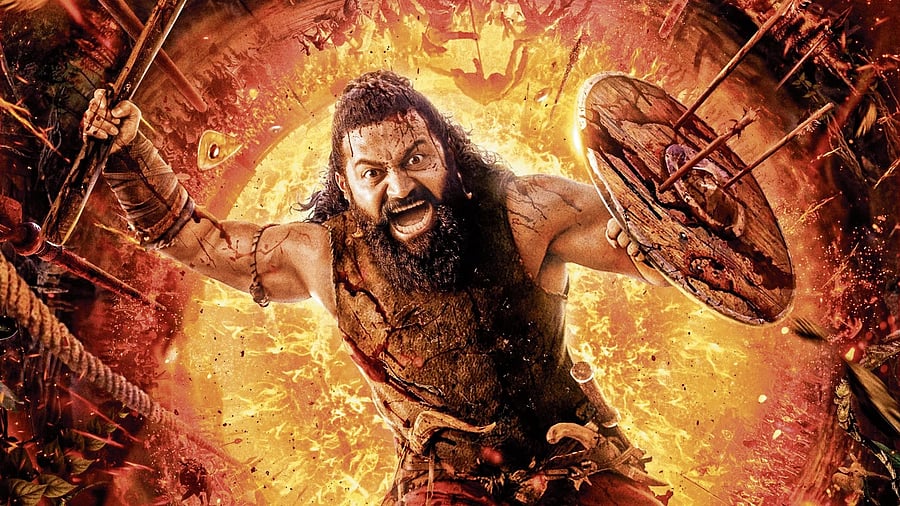
Rishab Shetty in ‘Kantara: Chapter 1’ poster.
Credit: DH Photos
In September 2022, Rishab Shetty's film Kantara was released with the tagline 'A legend'. Centred on Kambala (buffalo racing) and the bhoota aradhane (spirit worship), rituals of coastal Karnataka, the Kannada film wove in other themes — land ownership, land encroachment, forest laws, drinking, and landlordism — and won the audiences over.
Shetty, who portrayed the locally worshipped Panjurli spirit as a symbol of Vishnu's Varaha (boar) avatar, linked local traditions to Vedic traditions, and earned the appreciation of Hindutva supporters. Shiva, the protagonist, disappears, but in the process, the Guliga spirit possesses him, and kills the greedy landlord Devendra and his men. This roughly aligns with the stories of the bhoota worship. As portrayed in Tulu paad-danas (folk ballads, folk epics), the spirits pull off a heroic feat in their youth, fall victim to the conspiracies of the wealthy, die, and then become daivas (deities) to seek revenge against the wrongdoers. Kantara uses this narrative line.
Shetty succeeds in integrating the contemporary realities of Tulunadu with the narratives of daiva worship. Ultimately, Kantara, which drew inspiration from Tulunadu, ended up having a significant impact on Tulunadu. I have seen daiva dancers somewhat mimicking Shetty's Guliga act. Kantara brought respectability to the Kannada-speaking people of the state. It showed a world different from the world shown by Bengaluru-centric filmmakers, some of whom used to create caricatures and mock the coastal Kannada accent.
Since the 1870s, numerous books on bhoota worship have been published in Kannada and English, but it was Kantara that sparked curiosity in it among people from outside the coast. The use of traditional instruments and farmers’ songs in the background score added to the film’s appeal.
The prequel, Kantara Chapter 1, is not as effective. Shot in the wake of the sensational success of Kantara, its narration is thin. Yet, the film is a big commercial hit. In fact, it looks like the daiva possessed the audiences, both inside and outside the theatres.
Those who criticised the film faced a vicious backlash. Interestingly, when a complaint was made to a real-life daiva during a ritual, it said, "I will straighten out those making money in my name.” Meanwhile, Shetty has claimed: "I made the film only with the daiva's consent." Kantara Chapter 1 has created an uncanny atmosphere.
The film is set in the Kadamba era. Historically speaking, the period has no connection with daiva worship. King Vijayendra of Bangra, whose character is reminiscent of the Banga kings of Tulunadu, seeks control over Kantara’s sacred forest, but is killed by its guardian spirits. Years later, Vijayendra’s grandson King Kulasekhara attacks the village, but, led by Berma, a tribal youth, the king’s army is defeated. Suspicion and unrest between the Bangra kingdom and tribals continue. Finally, with divine intervention, Berma defeats the Bangra army and peace is restored in Kantara. The ending sequence leaves room for another film in this franchise.
Though entertaining, this commercial film, which blends history, mythology, and folklore with modern technology, lacks a historical grounding. Loud theatrics are depicted as bhoota worship. Shetty's acting and Rukmini Vasanth's cold gaze remain in memory for a while.
Kantara (2022) had a soul, but what happens when deep traditions are hijacked for commerce has happened to the prequel. The belief that ‘whenever mankind moves towards unrighteousness, Ishvara sends his ganas to earth’ is propagated here. It echoes Krishna’s words in the Bhagavad Gita: "Whenever righteousness declines and unrighteousness rises, I manifest to protect the good and destroy the wicked. I am born in every age."
Shetty, who equated Panjurli with Varaha in the first Kantara, has now linked bhoota worship with Hinduism, bagging the title of ‘divine star’. The film complements the Hindutva activities in coastal Karnataka. A Muslim daiva-like Bobbaryya, popular in Tulu narratives, is now being portrayed as an avatar of Babruvahana, a character from the Mahabharata.
The relationship between folk traditions and commercial cinema is complex. Commercial cinema draws inspiration from folk traditions for its stories, narratives, songs, and dances. But in its expression, it oversimplifies these traditions, framing folk traditions within the context of another, often opposing, culture, and presenting them in an entertaining way. To understand how local culture can be transformed and made marketable, watch Kantara Chapter 1.
While efforts to bring local traditions into the broader framework of Hinduism are underway everywhere, Kantara Chapter 1 has done this in its own unique way. If one understands that the hero Berma appearing in this film is not the Berma celebrated by Tuluvas as the creator of Tulunadu, many things become clearer.
Purushottama Bilimale is chairperson of Kannada Development Authority.
Disclaimer: The views expressed above are the author's own. They do not necessarily reflect the views of DH.